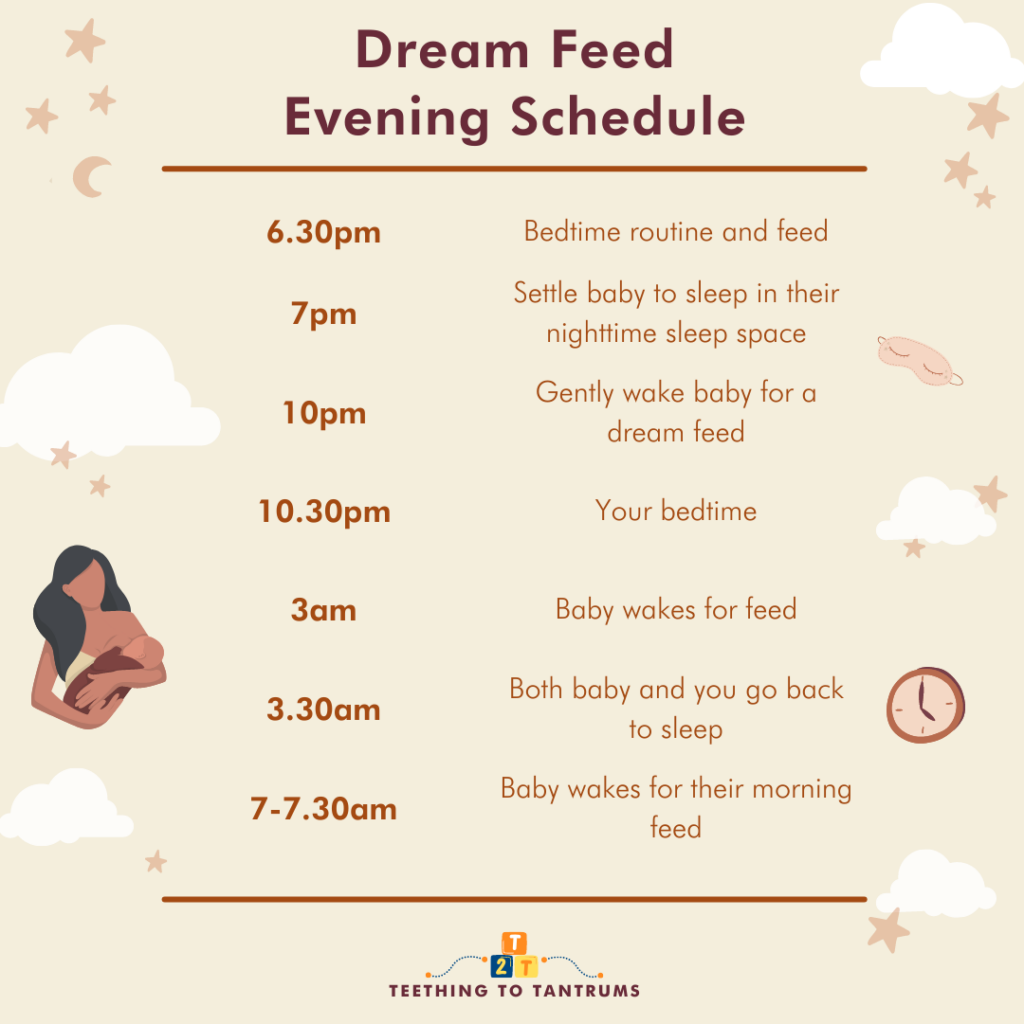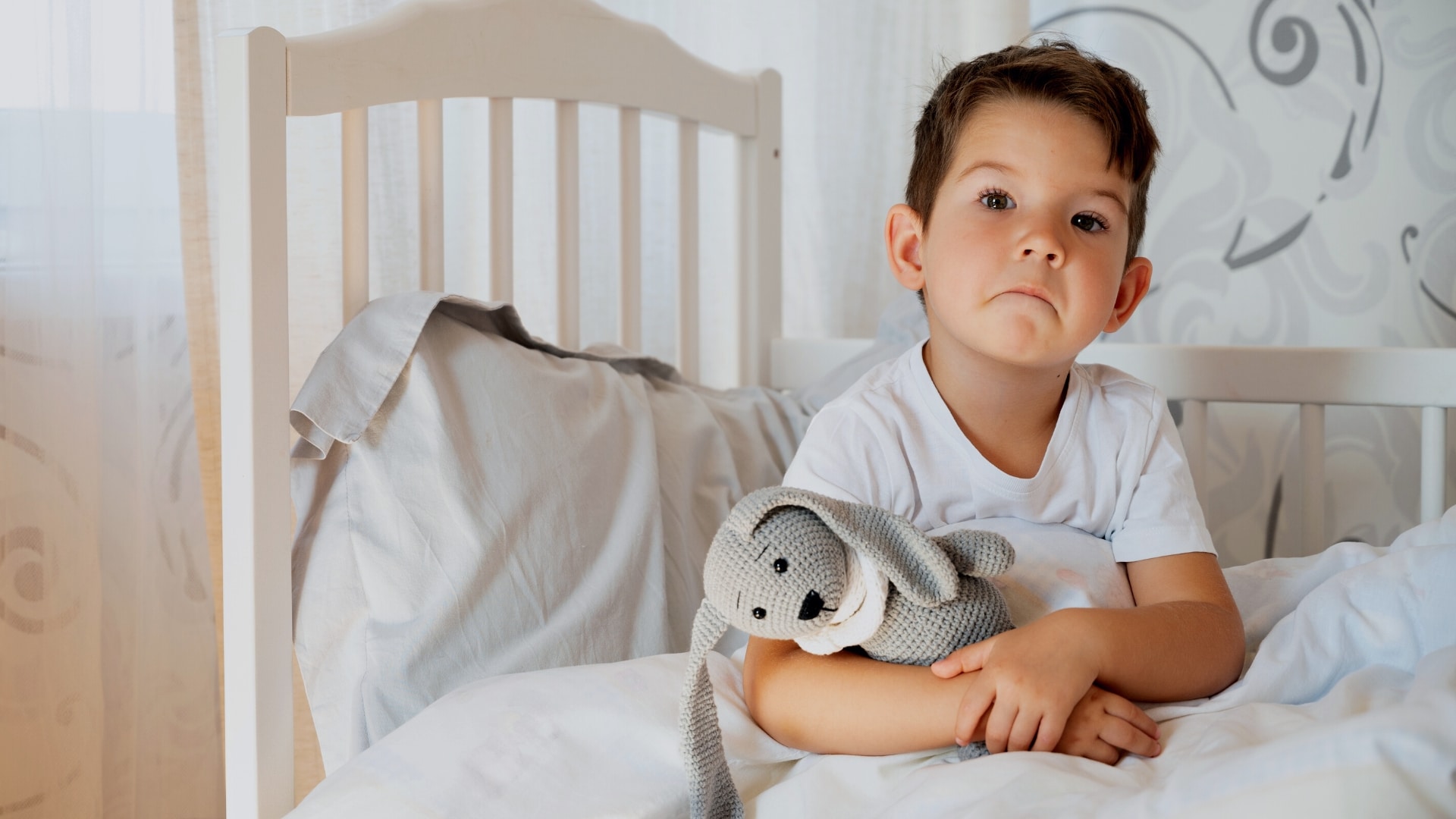Are you a sleep-deprived parent in search of a solution to help your baby sleep through the night?
You may have heard about the concept of a ‘dream feed’ from a friend or read about it in sleep training articles, but still have questions about how it works and if it’s right for your little one.
Well, you’re in the right place! Join us as we explore the ins and outs of dream feeding and how it can help you and your baby get more restful sleep.
What Is A Dream Feed?
A dream feed is when you offer an extra feed to baby in the late evening, just before you go to bed that involves you gently waking them for a feed rather than waiting for baby to fully wake for a feed in their own time. The aim is for this feed to allow baby to sleep through a large portion of the night, only waking to be fed once before the morning.
Why Is Dream Feeding Important?
Parents often dream feed in order to get a longer stretch of sleep before their baby wakes for the next feed. This can help both baby and parent feel refreshed and rested the following day.
During the first year of life, infants spend most of their time in the sleeping state. And adequate sleep improves overall functioning, and future cognitive, psychomotor, and temperament development in children…
So the more rested they are, the better.
What Time Should You Dream Feed Baby At?
Most dream feeds occur around 10pm.
As I mentioned above, this feed is taken just before you go to bed to ensure baby gets 4-5 hours of sleep before their next feed.
If you are going to feed your baby in this way, your evening and nighttime feeding schedule can look something like this:

| Time Of Day | Routine |
| 6.30pm | Bedtime feed |
| 7pm | Settle baby to bed in their nighttime sleep space |
| 10pm | Gently wake baby for dream feeding |
| 10.30pm | Your bedtime! |
| 3am | Baby wakes for a feed |
| 3.30am | Both baby and you go back to sleep for a period of sleep |
| 7.30am | Baby wakes to be fed |
At What Age Can You Dream Feed Baby?
You can begin to dream feed when baby is 3 months old.
Feeding at 10-11pm can be of huge benefit to maximise night sleep for both you and your baby and some parents use this trick until baby is 9 months of age.
REMEMBER: A newborn baby should NOT be dream fed yet, as it is essential that they feed every 3-4 hours to regain their birth weight and to keep your milk production constant.
Signs That Your Baby Can Begin To Dream Feed
Here are 4 signs that your baby (3 months+) is able to begin to feed in this way if you wish to do so:
- They have an established bedtime routine and sleep schedule
- They can go for 4-5 hours between feeds.
- They are gaining weight well.
- They are able to settle back to sleep after being fed easily.
Looking to get your little one to sleep quickly and effortlessly? Check out my Bedtime and Nap Cheat Sheet and master the art of making daytime naps and bedtimes as seamless as possible.
A bedtime & nap cheat sheet so good your little one will ask you to put them to bed...
Laura Williams "This is a life saver! I'm so glad I downloaded your bedtime & nap cheat sheet. My little one actually asked me to put him to bed last night! Unbelievable! Thank you so much!"
Click Here For The FREE Cheat Sheet
How Do You Wake Your Baby For A Dream Feed?
Sleep is so precious in the early months that it can be quite daunting to wake your baby when they are sleeping peacefully…
However, getting dream feeding right can gain you an extra precious hour of sleep when you need it most.
So, how do you wake your baby successfully for a feed if they are reluctant wakers?
Well firstly identify if your baby is in an active sleep period, known as REM sleep. They will be twitching, their eyelids may flutter and they may move their arms and legs around. You can then:
- Unswaddle them at the bottom and change their diaper.
- Rub a wet wipe gently on their cheek.
- Tickle the bottom of their feet (annoying them just enough to get them to latch onto the bottle or breast).
- Express some milk from the bottle or breast onto their lips. This often stimulates the sucking reflex.
- Following on from above, babies have a natural instinct to suck if they’re at a nipple or offered a teat so try presenting either a nipple or teat to gently wake them up.
How Much Do You Feed Baby During A Dream Feed?
You don’t need to worry about how much your baby takes during a late night feed. Think of it as a late-night snack rather than a full feed.
However, every baby is different so some may even take a full feed at this point.
My advice… Let your baby take the lead.
Any milk that you can get them to take at this point will go towards helping them to sleep for longer during the night.
Positives Of Dream Feeding With Your Baby
It is important to remember that you may need to try this style of feeding a few times before you get the hang of it, but when you do, there are amazing positives to introducing it:
- It extends both your and your baby’s nighttime sleep to reduce sleep deprivation and overtired sleep cycles.
- It reduces night wakings (and subsequently reduces unnecessary night feedings)
- It allows your partner to give the feed.
- Because dream feeds happen when your baby isn’t fully awake, it can help to break any suck-to-sleep associations
- Following on from above, these feeds can give you an early night.
- These evening feeds also help train your baby to sleep longer at night.
- A few extra hours of uninterrupted sleep can make a significant difference to your well-being as a parent
Considerations Of Dream Feeding With Your Baby
Of course, dream feeding will not be for everyone and not all babies or parents will take to ‘messing around’ with their feeding schedule.
Some cons of dream feeding can be:
- It can be difficult to wean your baby off the evening feed
- If your baby suffers from reflux they may not tolerate a top-up feed and will be better off being left to wake when they have an empty tummy.
- Some babies may struggle to go back into a deep sleep after a feed (which would defeat the whole point of offering this feed)
- Some babies will find the dream feed disrupts their natural sleep patterns making them irritable and unsettled. If this happens, drop the feed and let them wake naturally.
When And How To Drop The Dream Feed
You can consider dropping the feed once your baby is regularly sleeping through the night from the dream feed right through till their morning feed at around 6.30-7am.
Bottle-fed babies often continue night feedings until they’re around 6 months old, whereas breastfed babies may continue up to a year, so bear this in mind too.
When you are ready to wean baby off, you should:
- Gradually reduce the amount of breast milk or formula you are offering at the feed.
- Gradually reduce the amount of time you feed baby for.
- Bring the feed earlier every evening until you reach 9pm and then drop it completely.
Whatever you decide, your baby should be ready to drop this feed once they are having 3 regular meals a day.
TOP TIP: Deciding to dream feed and deciding when to drop the feed is, ultimately, a very personal decision. It is NOT a must-do for every family, but for many parents, it works brilliantly and is a lifesaver.
Frequently Asked Questions About Dream Feeding
Looking for more information about dream feeds? Here are the answers to the most common questions.
Is Dream Feeding Safe?
Yes, dream feeding is perfectly safe as long as it is given while you are holding your baby correctly and they are sufficiently awake to suck enthusiastically.
NOTE: Never feed your baby in their crib or when they are lying on their back.
Can You Dream Feed When Baby Is Bottle-Fed?
The good news is that bottle-fed babies can absolutely be dream fed!
In fact, for mothers who are bottle feeding (either by expressing milk or feeding with formula), getting your partner to do the dream feed will give you a little break to have an early night whilst your partner experiences the wonderful bonding moment of feeding baby.
Which is a win-win for everyone.
Will Dream Feeding Affect Milk Supply?
No, dream feeding should not affect your breast milk supply. As long as you breastfeed or pump regularly over 24-hours, feeding in this way can help you maintain your milk supply.
Do You Burp Baby After A Dream Feed?
Yes, you should burp your baby after dream feeding just as you would after any other night feed.
Of course, you will know your baby and what they can manage with regard to nighttime burping.
Some babies will burp after every feed…
Some babies need a bit of persuasion…
And some little ones won’t burp at all!
When To Consult A Doctor About Dream Feeds
It is important that your baby has established a healthy weight gain before you introduce a dream feed.
Until this point, your baby will need regular feeds and should not be sleeping for longer than 4 hours between feeds.
Generally, you do not need to consult a doctor before you try dream feeding. However, if you need that little extra assurance then by all means get some medical advice or chat to a sleep consultant before you decide to try this style of feeding.
Need More Parenting Help?
- Download our FREE Bedtime & Nap Sleep Cheat Sheet. It’s a free, easy-to-use and proven formula designed for parents of 0-5 year olds to master the art of consistently undisturbed and restful sleep without the yelling, nagging or exhausting long-winded evenings.
- Check out our Parenting Toolbox. You’ll get access to expertly-chosen products that you can guarantee are the best for your little one and your wallet.
- Are you looking for personalized guidance to navigate the challenges of parenting? I offer 1-on-1 consultations to bring you tailored strategies and actionable advice to help support your child's growth and well-being with confidence.

A bedtime & nap cheat sheet so good your little one will ask you to put them to bed...
Laura Williams "This is a life saver! I'm so glad I downloaded your bedtime & nap cheat sheet. My little one actually asked me to put him to bed last night! Unbelievable! Thank you so much!"
Click Here For The FREE Cheat Sheet


